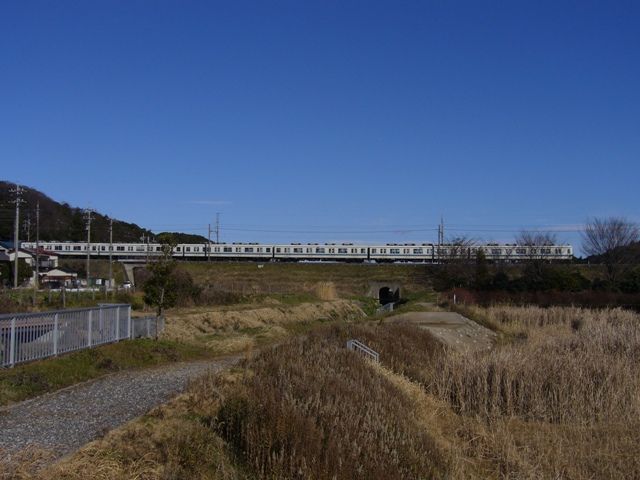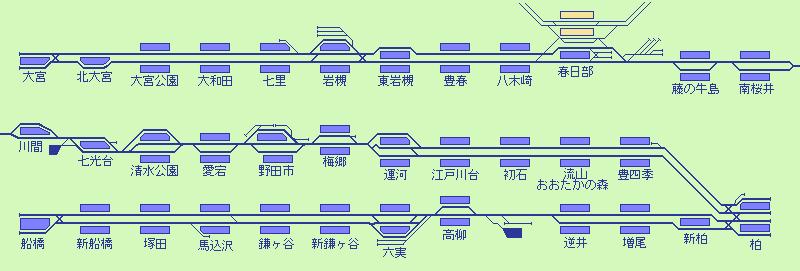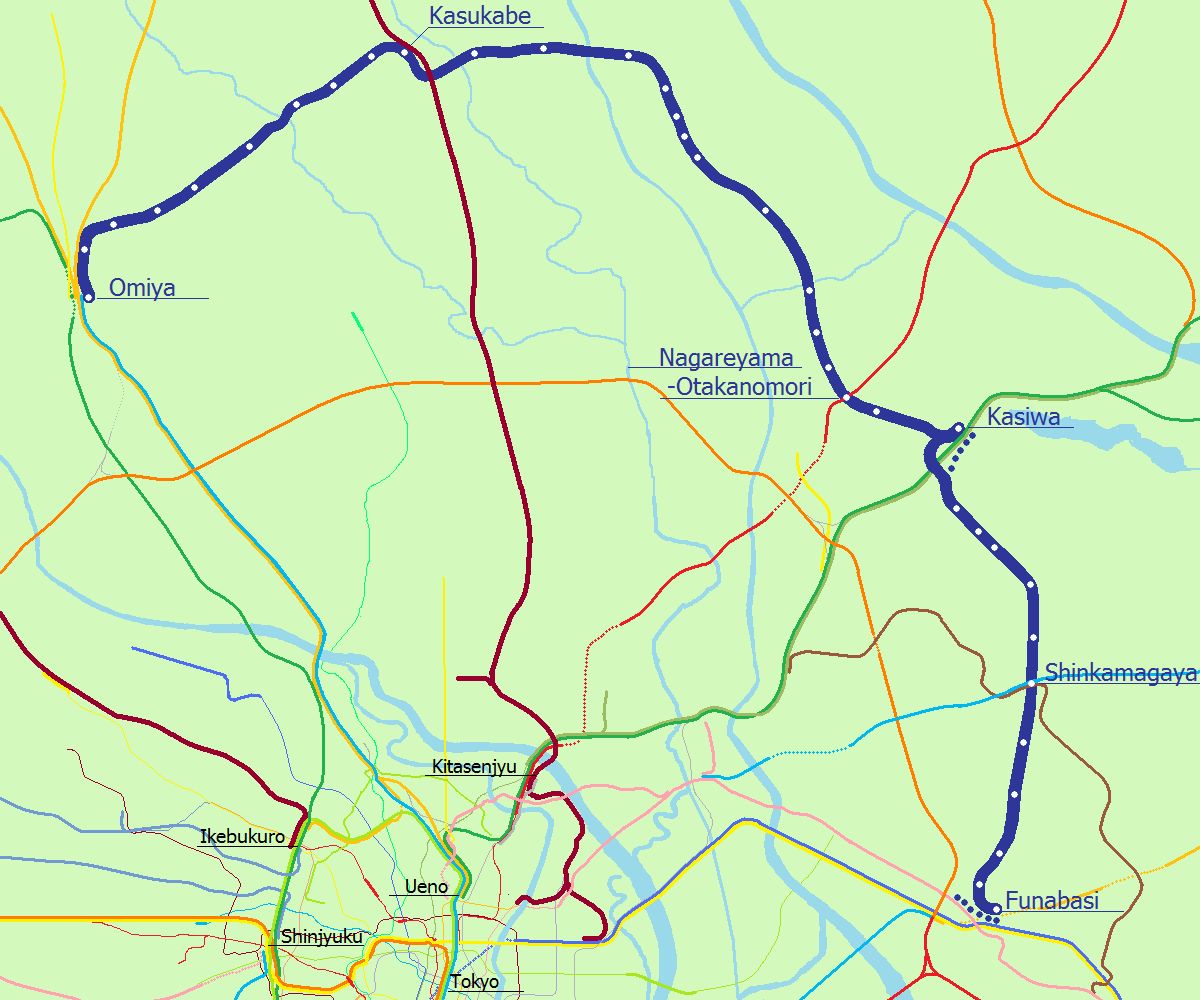
introduction of Tobu noda line

Between Takayanagi and Sakasai, under winter sky runs Tobu series 8000
-- basical data --
Train runs 62.7 km in an hour and half. Max speed is 100km/h, but 85km/h in most interval between stations.
This is because average distance is 1.88km, short to accerelate before reach max speed.
Train, consists of 6 cars, runs in every 5minutes in rush hour and every 10minutes in daytime.
Train is crowded as it runs to junctions, and less crowded as it runs against junctions.
Interior of trains is bench seat, no romance seat, so it is like a metro.

Omiya (change trains to JR tohoku line, takasaki line, kawagoe line, tohoku shinkansen, joetu shinkansen and new suttle)
- kitaomiya - Omiyakouen - Owada - Nanasato - Iwatuki - Higasiiwatuki - Toyoharu - Yagizaki -
Kasukabe (change trains to Tobu isezaki line)
- Fujinousijima - Minamisakurai - Kawama - Nanakoudai - Simizukouen - Atago - Nodasi - Umesato - Unga - Edogawadai - Hatuisi -
Nagareyama-Otakanomori (change trains to Tukuba express)
- Toyosiki -
Kasiwa (switchback station, change trains to JR Jyoban line)
- Shinkasiwa - Masuo - Sakasai - Takayanagi - Mutumi -
Shinkamagaya (change trains to Hokuso line and Shinkeisei line)
- Kamagaya - Magomezawa - Tukada - Shinfunabasi -
Funabasi (change trains to JR sobu line and Keisei line)

Seen from railline above, some intervals are left single line on Noda line. Base of trains is placed near Nanakoudai station, and several stock lines there is between Takayanagi and Sakasai, and Kasukabe station. Kasiwa station is switchback-station, but few trains run through Omiya side to Funabasi side.
-- advanced data about Tobu Noda Line --
Tobu Noda Line, typical suburban train as maps indicate, runs around tokyo.
Most passenger takes train to nearer junction, commuters, students and other passengers.
However, on the nearest stations to junctions, buses are also available, so number of passenger uses these station is low.


"--"indicates junction station, "vv""^^"indicates flow of passensers guess.
*:sum of passenger between Fujinousima and Simizukouen
cited from,http://www.tobu.co.jp/rail/frail_2_2.html, (2008.11.1)
However, the time need to go from junction to Tokyo station is as showed.
Omiya > (change trains at Ueno) > Tokyo (
Touhoku line and
yamanote line 32min.\540)
Kasukabe > Otemachi(near Tokyo) (
Tobu Isezaki Line and
Tokyo metro hanzoumon line 54min.\640)
Kasukabe > (change trains at Kitasenjyu) > Otemachi(near Tokyo) (
Tobu Isezaki line and
Tokyo metro chiyoda line 45min.\590)
Nagareyama-Otakanomori > (change trains at Akihabara) > Tokyo (
Tukuba express and
Yamanote line 29min.\730)
Kasiwa > (change trains at nippori) > Tokyo (
Joban line and
Yamanote line 37min.\540)
Shinkamagaya > Nihonbasi (
Hokusoukoudansen,
Keisei osiage line and
toei subway asakusa line 41min.\920)
Shinkamagaya > (change trains at Matudo and Ueno) > Tokyo (
Shinkeisei line,
JR joban line and
Yamanote line 48min.\570)
Funabasi > Tokyo (
JR soubu line 32min.\380)
Cited from yahoo!japan transit search,http://transit.yahoo.co.jp/,(2008.10.31)departure at 12:00
-- short history of Tobu Noda line --
May,1911 saw start service between Noda and Kasiwa, main purpose of this line was freight service of soysauce.
1922 is ablished Hokusou-railway and Funabasi between Kasiwaopened without erectric facilities in 1923. Train was consist of one or two 4-wheeled short gasorine car. Tobu noda line was rural transportation.
In 1929 Noda Line crossed Edogawa, and all line was connected in 1930. This line was build into Tobu Railway Company in 1944. In 1947 all rine was erectricized.
According to population explosion and subsequent population movement towards suburban, from 1960 was started to make the line double, and now between Kasukabe and Unga, Sakasai and Mutumi are left single line.
Trains are also changed from 15meter crassic cars through 18meter body-converted cars, and at last to 20meter high-speed and air-conditioned cars.
And now, Tobu Noda line become typical suburban train, which runs between houses and apartment houses, also across rice field,field of vegetables, woods and orchards.
reference:color books Japanese private railway company 10 Tobu,Hoikusha,(1991)
see also ...
ⓒ2005~ takofu-mi All rights reserved



 top page > introduction of Tobu Noda line
top page > introduction of Tobu Noda line






